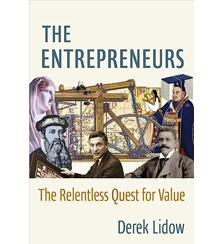The mechanics of entrepreneurship
A study of centuries of entrepreneurs shows how important collaboration and mutually reinforcing actions are to innovation.

The Entrepreneurs: The Relentless Quest for Value
by Derek Lidow, Columbia University Press, 2022
Forget the myth of the hermetic genius working in the garage on the next world-changing startup. It’s time to upgrade that thinking and pay more attention to how much entrepreneurial innovation is woven into the fabric of daily life.
So says Derek Lidow, a Princeton professor and former corporate executive. Lidow is the author of The Entrepreneurs: The Relentless Quest for Value, which analyzes the factors that give rise to entrepreneurs—and, in turn, the important social changes brought about by their innovations. In a nod to the thinking of the political economist Joseph Schumpeter, Lidow writes that entrepreneurship is “a vastly underappreciated, potent force of social change.”
Drawing on thousands of years of entrepreneurial history, from “the Neolithic bead-producing people of Wadi Jilad” to Marie Tussaud, Lidow argues that social trends have been central to invention. It was the development of a materialistic class of consumers that enabled entrepreneurs such as Josiah Wedgwood to mass-produce fine branded products in the 18th century. And the evolution of urban centers at the turn of the 20th century allowed Harry Selfridge to create the idea of the modern department store by innovating ways to attract and serve customers.
Lidow underlines that entrepreneurs, counter to conventional wisdom, don’t go it alone. His notion of “entrepreneurial swarming” holds that it is often groups of enterprising people who collectively transform society through reinforcing behaviors.
“Much of the world we live in today was created by swarms of entrepreneurs relentlessly innovating,” he writes, pointing to the chipmaker Robert Noyce. Noyce partnered with a group of like-minded technologists in Silicon Valley in the late 1950s to create the integrated circuit that would become the foundation of the Information Age.
As key drivers of innovation, clusters of entrepreneurs spread knowledge rapidly and pressure peers to adopt new skills and technology. They are, according to Lidow, a force more powerful than the “invisible hand.” In his parlance, their power is more akin to an “invisible shove” toward ever-accelerating progress.
According to Lidow, entrepreneurs are a force more powerful than the ‘invisible hand.’ Their power is more akin to an ‘invisible shove’ toward ever-accelerating progress.
Lidow codifies this innovative shove, arguing that entrepreneurs invent and create enduring change in one of three ways: by scaling supply, scaling demand, or scaling simplicity.
The first category includes those who scaled up their supply by devising an efficient system and then repeating it. In the late 1700s, the enterprising coin-maker Matthew Boulton, for example, leveraged his superior knowledge of metalworking to create a new process for producing coins quickly and uniformly—spawning countless societal changes. This included the swarm of entrepreneurs in the early- to mid-1800s who conceived the modern railway.
Titans of the second category, scaled demand, include cultivators of desire like Wedgwood, Selfridge, and the American PR pioneer Edward Bernays, who coined the phrase “public relations” and created the industry. Through carefully cultivated propaganda campaigns, Bernays convinced wide swaths of folks in the US to support the country’s efforts in World War I and, later, stimulated broad demand for products such as bacon and tobacco.
Entrepreneurs who capitalized on innovations such as the modern cash register and integrated circuit constitute the category of scaled simplicity. Lidow traces this thread through the technology pioneers of the 20th century, including Digital Equipment Corporation founder Ken Olsen (creator of the minicomputer) and Dan Bricklin (inventor of the modern spreadsheet). These entrepreneurs and others like them (think Steve Jobs) found a way to translate technologically complex items into inviting tools through the development of a clear, user-friendly interface. They made the purpose of their inventions obvious and easy for the consumer to access.
But entrepreneurship is a two-way street—and Lidow doesn’t shy away from exploring some of its damaging history. “We must acknowledge the contributions of entrepreneurs even as we hold them accountable for the problems they have caused,” he states, noting that “we have been naïve in our understanding of how entrepreneurship works and why forces beyond [entrepreneurs’] control lead them to act in ways that are not considerate of others, particularly noncustomers.”
Readers seeking easy tips for becoming a successful entrepreneur may be disappointed, because Lidow’s historical journey is far more descriptive than prescriptive. (They might be better served with a classic of this field, like Peter Drucker’s Innovation and Entrepreneurship.) But, at a time when many of our best-known entrepreneurs of recent years are reckoning with the unintended consequences of their innovations, Lidow has crafted a useful perspective on the “quest for value” at the heart of most entrepreneurial adventures. The Entrepreneurs nudges us to appreciate those successful actors who have capitalized on broader change, created material improvements in how we work and live cooperatively, and left a legacy for others to build on.
Author profile:
- Tom Ehrenfeld is a freelance writer and editor based in Cambridge, Mass. Formerly a writer/editor with Inc. magazine and Harvard Business Review, he is also the author of The Startup Garden. He has written extensively about lean enterprise; nine books that he has edited have won the Shingo Publication Award.


